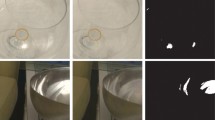Abstract
Many visual tasks of intelligent robots as object detection and tracking are very easily interfered by the specular highlights. Existing highlight detection and removal methods often suffer from low sensitivity in dealing with low saturation pixels and large-area highlight, and there are visual artifacts and information distortions in the compensated pixels. In this paper, we propose a novel two-stage convolution neural network (Bifurcated-CNN), to tackle the problem of specular highlight detection and removal on high-reflective materials. 1) The specular highlight features are extracted and removed in two stages from coarse to fine, so as to ensure the generation of diffuse images have no visual artifacts and information distortions. 2) We propose a bifurcated feature selection strategy (BFSS) to filter out the specular highlight features, which enhances the detection capability of our network. 3) Experimental results demonstrate that the proposed network is more effective to remove specular highlight with a 0.06 × 1e−2 reduction in MSE, a 2.4831 improvement in PSNR, and almost the same in SSIM, compared with the state-of-the-arts. In addition, we build a large-scale transparent solid waste highlight dataset, which will help the solid waste sorting robots to solve the detection failure problems caused by specular highlight, and greatly contribute to accurate visual sorting in the plastic solid waste recycling industry. It is also helpful to evaluate and encourage new deep-learning methods. As we know, this is the first specular highlight dataset for the plastic solid waste recycling industry. The dataset will be made available at https://github.com/aobi12138/Bifurcated-CNN.
Access this chapter
Tax calculation will be finalised at checkout
Purchases are for personal use only
Similar content being viewed by others
References
Ranyang, L., Junjun, P., Yaqing, S., et al.: Specular reflections removal for endoscopic image sequences with adaptive-RPCA decomposition. IEEE Trans. Med. Imaging 39(2), 328–340 (2019)
Wuming, Z., Xi, Z., Jean-Marie, M., et al.: Improving shadow suppression for illumination robust face recognition. IEEE Trans. Pattern Anal. Mach. Intell. 41(3), 611–624 (2018)
Qingxiong, Y., Jinhui, T., Narendra, A.: Efficient and robust specular highlight removal. IEEE Trans. Pattern Anal. Mach. Intell. 37(6), 1304–1311 (2014)
Jian, S., Yue, D., Hao, S., et al.: Learning non-lambertian object intrinsics across shapenet categories. In: IEEE Computer Vision and Pattern Recognition (CVPR), pp. 1685–1694 (2017)
Xing, W., Xiaobin, X., Jiawei, Z., et al.: Specular highlight reduction with known surface geometry. Comput. Vis. Image Underst. 168, 132–144 (2018)
Gang, F., Qing, Z., Qifeng, L., et al.: Learning to detect specular highlight from real-world images. In: Proceedings of the 28th ACM International Conference on Multimedia, pp. 1873–1881. Association for Computing Machinery, New York (2020)
Gang, F., Qing, Z., Lei, Z., et al.: A multi-task network for joint specular highlight detection and removal. In: IEEE Conference on Computer Vision and Pattern Recognition (CVPR), pp. 7748–7757 (2021)
John, L., Mohamed, E., Mohamed, T., et al.: Deep multi-class adversarial specularity removal. In: Scandinavian Conference on Image Analysis, pp. 3–15 (2019)
Isabel, F., Sebastian, B., Carina, R., et al.: Generative adversarial networks for specular highlight removal in endoscopic images. In: Image-Guided Procedures, Robotic Interventions, and Modeling, p. 9 (2018)
Takahisa, Y., Toshihiro, K., Ryota, K.: Efficient improvement method for separation of reflection components based on an energy function. In: IEEE international Conference on Image Processing (ICIP), pp. 4222–4226 (2017)
Tan, R., Ikeuchi, K.: Separating reflection components of textured surfaces using a single image. IEEE Trans. Pattern Anal. Mach. Intell. 27(2), 178–193 (2005)
Zhongqi, W., Chuanqing, Z., Jian, S., et al.: Single-image specular highlight removal via real-world dataset construction. IEEE Trans. Multimedia 1 (2021)
Author information
Authors and Affiliations
Corresponding author
Editor information
Editors and Affiliations
Rights and permissions
Copyright information
© 2022 The Author(s), under exclusive license to Springer Nature Switzerland AG
About this paper
Cite this paper
Xu, J., Liu, S., Chen, G., Liu, Q. (2022). Highlight Detection and Removal Method Based on Bifurcated-CNN. In: Liu, H., et al. Intelligent Robotics and Applications. ICIRA 2022. Lecture Notes in Computer Science(), vol 13458. Springer, Cham. https://doi.org/10.1007/978-3-031-13841-6_29
Download citation
DOI: https://doi.org/10.1007/978-3-031-13841-6_29
Published:
Publisher Name: Springer, Cham
Print ISBN: 978-3-031-13840-9
Online ISBN: 978-3-031-13841-6
eBook Packages: Computer ScienceComputer Science (R0)




